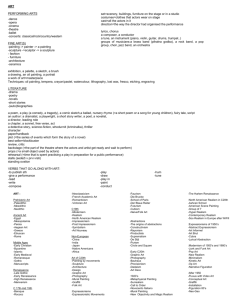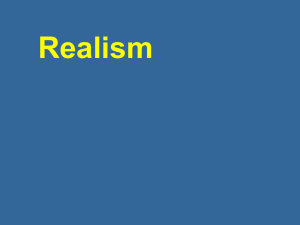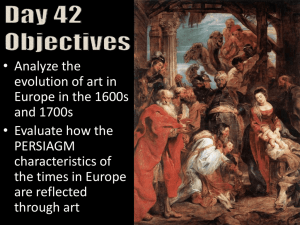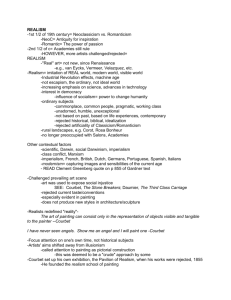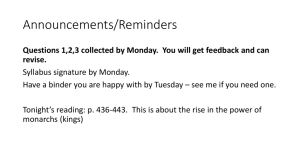Italian Renaissance Art
advertisement
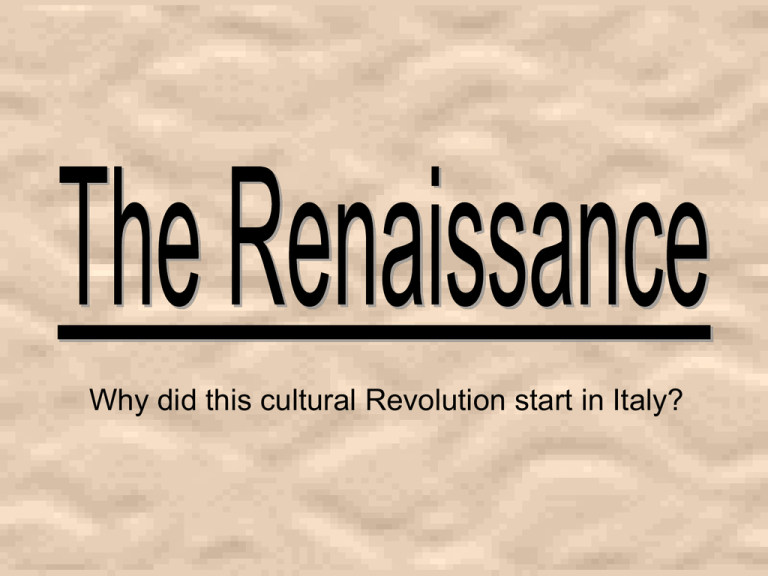
Why did this cultural Revolution start in Italy? What is the Renaissance? Began around 1350 in Italy Characterized by a renewed interest in the past. Why did it occur? / During the 11th and 12th centuries, Europe benefited from a warm climate that enabled a larger supply of crops. A larger supply of crops allowed Italy’s economy to grow. As a result, the elite class of society increased allowing individuals to become scholars who could study the past. Who are Humanists? Studied how to lead a proper life according to the ancient Greeks and Romans through their literature The Italian scholars emphasized the study of several subjects: grammar, rhetoric, history, and poetry, while using classical texts. These subjects are called the humanities and the individuals who study these subjects are called humanists. What do humanists believe? / Studying the classical texts led Humanists to believe that it was important to learn how things worked, to emphasize education, led a meaningful life, and to financially support the arts. Humanists celebrate both life and the afterlife. Art and Patronage Italians were willing to spend a lot of money on art. / Art communicated social, political, and spiritual values. / Italian banking & international trade interests had the money. Public art in Florence was organized and supported by guilds. Therefore, the consumption of art was used as a form of competition for social & political status! For instance, a person would pay for art to show how wealthy and powerful they were. New Techniques Fresco Perspective Human anatomy and movement Sculpture Architecture Painting done on fresh, wet plaster with water based paints, 3-D Organization of outdoor space and light through geometry Realism of humans Donatello- Greek and Roman influence Brunelleschi- focused on human needs not divine Characteristics Carousel Objective: / To learn about the SIX characteristics of Renaissance Art Directions: / In pairs, you will be assigned a COLOR / Travel around the room, in a clockwise direction, to complete your learning guide / You must DRAW ON YOUR LEARNING GUIDE in order to receive credit Return to your seat when you have completed your learning guide! Time Allowed: 20 minutes 1. Realism & Expression i) Realism: showing scenes as they actually appear ii) Expression is different depending on the individual and the scene The emotions showed matched the subject or story told iii) First nudes since classical times. iv) Expulsion from the Garden Masaccio 1427 Realism & Expression Voice of God expelling Adam and Eve from the Garden. Realism is shown through the detail in Adam and Eve’s Anatomy Look at the expressions of Adam and Eve as they get kicked out of the garden of Eden. Are they happy about it? 2. Perspective i) Perspective: a graphic system that creates the illusion of depth and volume on a twodimensional surface ii) Draw on your paper iii)First use of linear perspective (using lines to show distance and depth) iv) Painting information: The Trinity Masaccio 1427 What you are, I once was; what I am, you will become. Perspective Where is the vanishing point? This painting shows Jesus, God, and the Holy Spirit. The Holy spirit is symbolized by the dove above Jesus’ head. 3. Classicism i) Classicism: Greek and Roman influence where perfect proportion is the ideal ii) Secularism- without religious influence Humanism-emphasizes reason, scientific inquiry, and human fulfillment in the natural world iii) Individualism free standing figures; S curve a curve shaped like an S that the side of the body makes v) The “Classical Pose” iv) Symmetry/Balance Medici “Venus” Classicism S Curve was used to show a more natural human standing position. This image is classical because it shows an ideal nude. In other words, this is an image of a perfectly beautiful woman. Contrapposto is used to show a relaxed human standing position. 4. Emphasis on Individualism i) Individualism: highlighting specific characteristics to show how one subject is unique from another ii) Circle your painting. iii) Revolutionary? i) Perspective ii) Realism/ Expression iv) Battista Sforza & Federico de Montefeltre: The Duke & Dutchess of Urbino Piero della Francesca, 1465-1466. Emphasis on Individualism What makes the Duke of Urbino not look like anyone else? What are his distinguishing facial features? 5. Geometrical Arrangement of Figures i) Geometric Arrangement: the arrangement of figures to form geometric shapes ii) Draw on your painting. iii) Revolutionary? Realism/ expression Classicism Perspective iv) The figure as architecture! v) The Dreyfus Madonna with the Pomegranate Leonardo da Vinci 1469 Geometrical Arrangement of Figures Why is the top of the triangle Mary and Jesus’ face? The most important point of a triangle is the top point; as a result, the top of the triangle forms Mary and Jesus’ face to draw the audience’s attention to their expression. 6. Light & Shadowing/Softening Edges i) Sfumato i) Define chiaroscuro: i) the use of extreme contrast between light and dark to create a dramatic effect ii) sfumato: The blurring or softening of sharp outlines by gradually blending one tone into another. ii) Illustrate on your painting. i) Revolutionary? i) Realism, Expression, Individualism v) Leonardo da Vinci, Ginevra de' Benci, c. 1474/1478, oil on panel, National Gallery of Art, Ailsa Mellon Bruce Fund 6. Light & Shadowing/Softening Edges Sfumato Chiaroscuro Partner Work to Group Work On the next slide, we will discuss a painting from the Renaissance to assess your knowledge of Renaissance art techniques. Participate to earn participation points Complete your learning guide by drawing the characteristics on your paper. Whole Group Discussion: Six Characteristics of Renaissance Art Content Check
